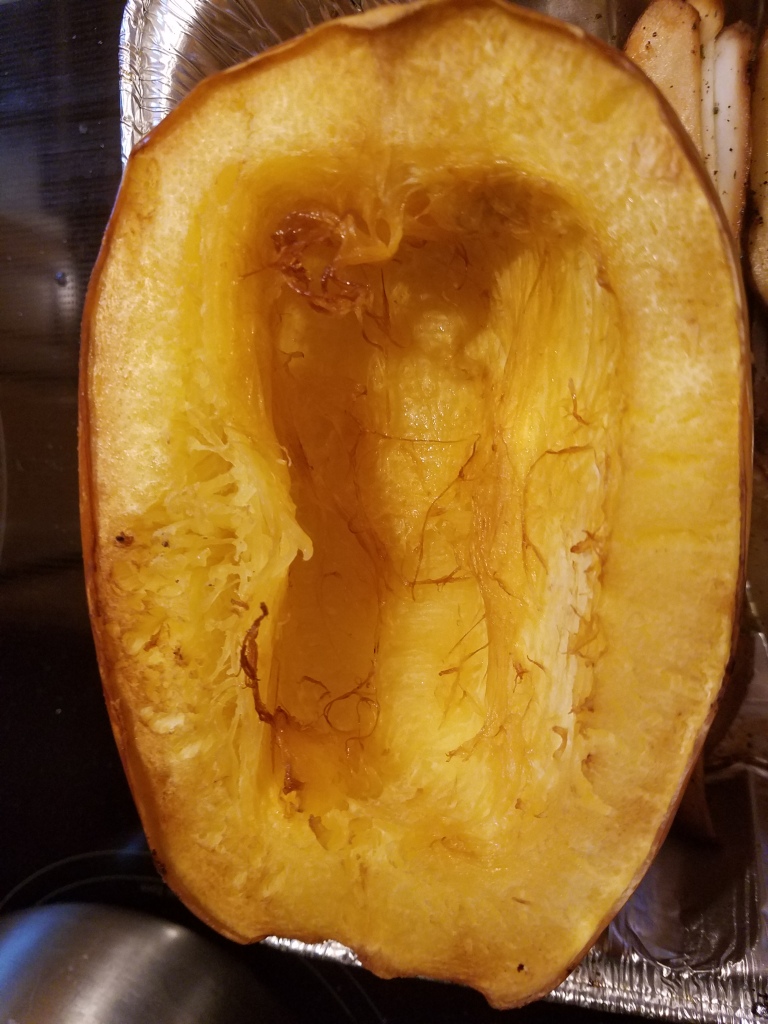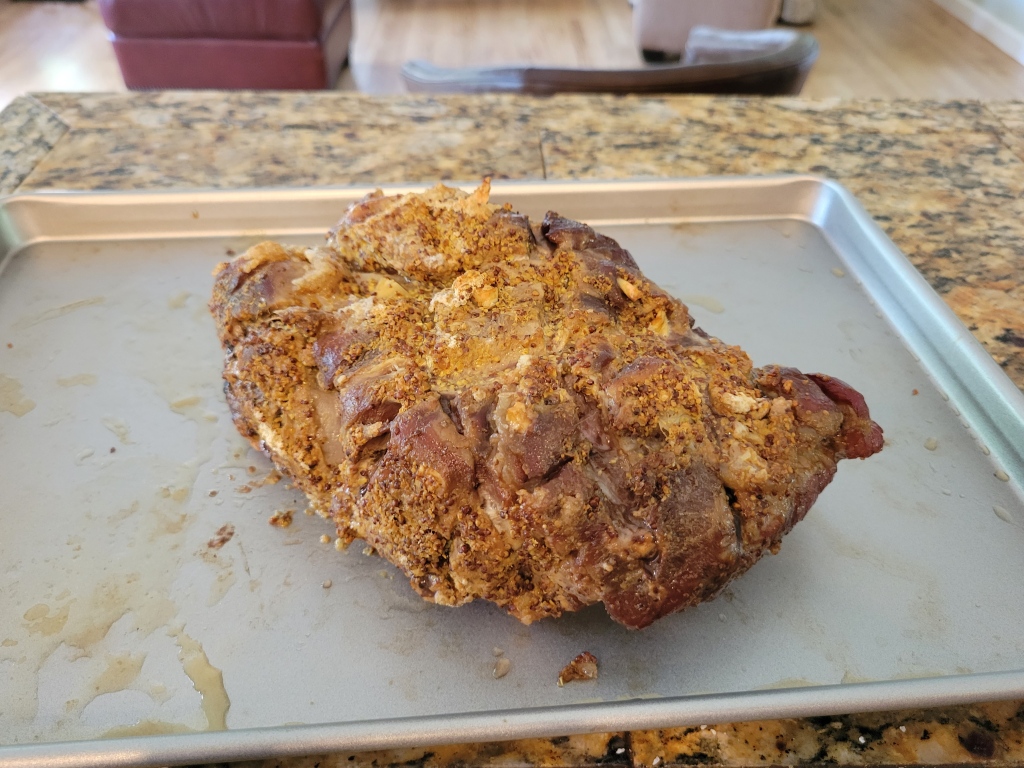In retirement I’ve been reading cookbooks on grilling and smoking. I’ve tried a lot of new things both smoking and grilling. Some from recipes and many things I’ve put together with Lynn’s input. Lynn does not do the “danger cooking” outside either on the grill or smoking.
I read several hundred customer product reviews before buying a smoker. I got an analogue electric smoker that uses the same sort of heating element that an electric frying pan uses. I have radio signal thermometers that run about $20 from Wal-mart and run off batteries. The smoker is about as inexpensive a smoker as you can get.
I drew the following conclusions about smokers from the myriad of smoker product reviews I read. First, if you use a smoker whose heat source is wood (pellet or log chunks) they have a slight taste advantage but you have to monitor them very closely. Since smoking can take as long as five hours for a large roast – I did not want to be tied that closely to the machine. Electric smokers give up some taste on the margins, but are far less expensive and less aggravating to use.
For electric smokers – according to all of the user reviews I read you need to spend about $1,000+ to get one with reliable digital temperature controls and wifi. You can get almost the same degree of control with a $200 smoker and a $20 radio signal thermometer – so I went that route.
When smoking anything I fill up the water tray so the food does not try out and only need the smoke to go for the first 30 minutes or so. Unless I’m refilling the smoker multiple times during the day with more fresh food, I do not refill my wood tray.
Wood – I’ve used chipped wood that I’ve purchased (apple, cherry, hickory) and Hickory Nuts from my Auburn house. Hickory Nuts work great – but take a little more work. I use a hammer to split (or quarter) the Hickory Nut. If the meat is dried out I remove the meat or discard the nut. Using the nuts has the additional advantage of not harming the trees. I’ve both soaked the wood (or nuts) prior to smoking and put the wood in dry. We cannot tell any difference in taste between soaked wood that you drain the water off of or just using dry wood. I’ve stopped soaking my wood.
Smoking Squash
I’ve smoked three different types of squash with very different results. When smoking hard squash (Spaghetti Squash or Winter Squash) you split them in half and scoop out the big seeds before smoking. Below is an example with Spaghetti Squash.

I then lightly brush olive oil on the exposed squash flesh and heavily sprinkle large grain kosher salt. I put the squash flesh directly on the smoking rack (the rind is up and the flesh on the rack).
Spaghetti squash takes about 3 hours to smoke to tenderness. I usually smoke things between 200 to 250 degrees. You test tenderness by taking a fork and seeing if the spaghetti elements easily pull away from the rind. I’ve smoked spaghetti squash with strong wood (Hickory) and mild wood (apple or cherry fruit wood). It comes out great with all types of wood.

My experiment smoking Winter Squash was unsuccessful. It took a very, very long time to smoke Winter Squash until it was tender – 4+ hours. Second, Winter Squash absorbed very little smoke taste. I think the only way Smoked Winter Squash makes any sense is to smoke it when you are doing a very large roast. Very large roasts take 4-5 hours to smoke. Next, I think the smoked winter squash is probably best used to make soup. As a stand alone side dish, Lynn and I did not think it was very tasty.
My Smoked Zucchini Squash turned out so-so. Zucchini readily absorbs smoke flavor. It gets tender quickly. However, the smoke flavor overwhelms the squash flavor. If you like the taste of smoky vegetables and don’t care for the taste of Zucchini – then smoking your squash will work out wonderfully. If you want some squash flavor – then don’t smoke the Zucchini.

Smoking Potato Wedges I tried smoking potato wedges. Lynn cut the wedges small and tossed them with olive oil, rosemary, and some other common roast potato spices. I put them into an aluminum chicken roasting pan and smoked them – seemingly forever (4 hours) at 225 to 250 degrees). They never got tender. I then tried a second batch at 400 degrees for four hours and they were edible, but not as tender as I would like. My conclusion is either I used the wrong cooking pan or the experiment was a failure. The heat transfer may not have worked very well since the aluminum pan reflects a lot of the heat and also runs it up the side of the pan. A flat, vegetable smoking tray would have probably worked better at transferring heat. I’ll probably attempt this one more time with a different tray.

Smoking Chicken Thighs All of my recipe books recommend smoking chicken thighs because they have a high fat content, are unlikely to dry out during smoking, and are inexpensive. I’ve smoked chicken thighs about a half a dozen times now. After some experimentation, I’ve settled on a very simple recipe. First, peel back the skin on the thighs and cut off any excess fat. Next, heavily sprinkle coarse kosher salt on the thighs. Then lightly sprinkle strong black pepper on the thighs. Put the skin back over the meat. Smoke the thighs directly on the rack using a remote read meat thermometer. Pull the thighs when the thermometer hits 160 degrees. I’ve been smoking about 24 thighs at a time. I then food-saver and freeze most of the thighs in four thigh packages. They have frozen very well for at least two months.

Smoking Roasts I have smoked Pork and Lamb roasts. All have turned out well, but after considerable experimentation this is my go-to recipe. Trim the excess fat off of the roast. Heavily slice into the meat about a half inch deep making a crisscross pattern on all sides. Generously sprinkle coarse Kosher salt over the entire roast. Then work in brown mustard with seeds (I use prepared, squeeze bottle mustard). You want to be sure to work the mustard and the salt deep into the cuts you made to prevent the mixture from falling off the meat while it cooks. Then, put the entire roast in a large ziplock bag and refrigerate over night.
Take the roast out about a half hour before you start smoking to bring the meat temperature up while you preheat your smoker. I take about a half a head of peeled, raw garlic and insert chunks into the meat. I place the chunks about an inch apart.
I’ve experimented on cooking temperature. If you want a crunchy bark, you will need to get an internal meat temperature of 165 to 170 degrees. If you want a more rare roast without the bark, smoke it to an internal temperature of 145 degrees. We have gradually moved to a temperature of 145 degrees, but with just two of us most of the meat is reheated in the microwave. Either way is good, just depends on your taste. We have fed lamb or pork roasts to many guests and everyone ate a lot and looked for more.

Sausage – Smoke, Grill or Boil? I did not learn how to properly grill sausage until this year. We think sausages taste best when they are very crispy on the outside while being thoroughly cooked on the inside. Burned sausages taste bad.
Boiled sausages avoid burning but you don’t get a crispy outside layer. This is the fool proof cooking method but is far from the tastiest method.
I smoked sausages this week. I inserted a meat thermometer into the end of the sausage to accurately assess the internal meat temperature. They were completely cooked and tender. But the smoke did not penetrate the meat very well and I did not get a crispy exterior. I think the sausage casing limits the smoke penetration. Smoking your sausages works fine (better than boiling), but the meat texture is not optimal.
I’ve attempted to grill sausages for decades with mostly poor results. Sausages are very fatty, and if the fat drips onto the coals (or the gas flame) you get a heat spike which tends to char the exterior of your sausage. I could occasionally cook the sausage completely and not burn the exterior – but this was a rare happy event.
This year I learned how to grill using indirect heat. I have a three burner propane grill at both houses. To use indirect heat you turn one burner (or the exterior 2 burners) on high and have the middle burner off. Your grill surface heats up to a high temperature, but because there is no direct heat source under your sausage you do not get heat spikes which char the exterior. Now my sausages turn out wonderfully! I preheat the exterior 2 burners on high. I grill the sausages in the middle with no direct heat. I pull the sausages when the instant read meat thermometer hits the right temperature. The exterior has a nice crunch. They are thoroughly cooked (essential for sausages) and there is no burning or charring on the exterior.
I plan to cook sausages on the grill using indirect heat instead of boiling or smoking.
Salmon – I have had poor luck grilling salmon. This is probably something that needs to be cooked using indirect heat – a technique I only recently learned. Fish also tends to stick to your grilling surface. I’ve used fish baskets – but this tends to under-cook the fish and the flesh sticks to the basket everywhere.
I’ve smoked salmon a couple of times and it has always turned out well. I suggest smoking the salmon on a cedar plank. The cedar gives it a nice flavor. I’ve read there are different types of cedar and some of the Chinese “cedar imports” produce inferior results. So shop carefully.
I lightly brush the salmon steak with olive oil and lightly sprinkle with coarse Kosher Salt. I put the salmon steak on the cedar plank skin side down and use my remote read meat thermometer. It has turned out well every time, but the cedar plank does improve the taste. I’ve given up on grilling salmon and plan to use my smoker in the future.
Smoked Macaroni and Cheese I’ve made this once closely following the recipe in Bill West’s cookbook (reference below). It was just amazing! We used whole wheat pasta for diabetes reasons which is not to everyone’s taste. But Smoked Macaroni and Cheese done properly is excellent. Sorry I did not take pictures.
Smoked Boiled Eggs – I’ve done this once. It worked pretty well, but I think I can improve. I’m holding off writing specifics until I improve my technique.
I hope you have found my grilling and smoking results to be interesting and helpful. Not everything I’ve tried has worked, but some of my attempts produce excellent results for me every time. I’ve also found that using coarse Kosher Salt on my smoked foods tends to preserve the food longer than skipping the salt.
The most useful smoking cookbook I’ve read so far is The Complete Electric Smoker Cookbook by Bill West. I’ve read half a dozen smoking cookbooks and this one is my favorite. It is only $15 new in paperback with a plastic type cover.